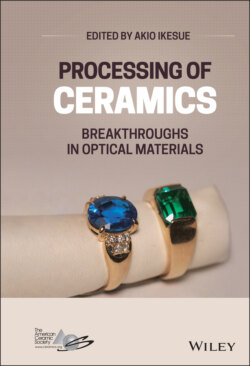Читать книгу Processing of Ceramics - Группа авторов - Страница 19
2.1 Background
ОглавлениеLasers are generally classified into (i) semiconductor lasers, (ii) gas lasers, and (iii) solid‐state lasers and applied to various fields.
Regarding solid‐state lasers, research, and development on various lasers have been carried out with the discovery of ruby laser by Dr. Maiman in 1960 as a trigger. Among them, continuous‐wave laser oscillation at room temperature using Nd:YAG single crystal by Dr. Guseic in 1964 and tunable ultra‐short pulse laser using Ti:Sapphire single crystal by Dr. P. F. Moulton in 1982 are technically excellent, and it is still applied industrially.
Solid‐state laser gain medium is used as a so‐called “coherence converter of light” that converts white light into coherent light; hence, the obtained yield (conversion efficiency) of coherent light is obtained with respect to excitation light energy decreases. However, the important thing is the nature of coherence light. As the energy density is remarkably high when collimated, and even small energy can be applied to high‐precision processing technologies such as laser marking and cutting. Since the laser amplifies the coherent light inside the gain medium while injecting the excitation light, very low optical scattering and very good optical uniformity are required as a laser gain medium. For this reason, glass or single crystals have been used conventionally. Since the former can synthesize a large laser gain medium, it is generally used for drivers in laser fusion, but because of its low thermal conductivity, it is difficult to repeat lasing and continuous oscillation of the laser. Single crystal materials are excellent in thermo‐mechanical properties and can be easily used for industrial laser because they can oscillate in continuous‐wave and pulsed laser mode. However, it is difficult to manufacture gain media on large scale, and it is also difficult to generate large output power.
When a transition metal element such as Cr, Ti, etc. or a lanthanide rare earth element such as Nd, Yb, Er, etc. is added to a laser gain material, these laser‐active elements absorb light energy of a specific wavelength and then emit fluorescence. Strong monochromatic light obtained by stimulated emission of the fluorescent rays inside the optical resonator is laser. Conventionally, white light such as a flash lamp or an arc lamp was used as an excitation source, but the absorption wavelength band of the laser active element in the laser host is very narrow and only a very small part of the white light can be converted into laser light. Therefore, the conversion efficiency was very low.
In recent years, by using a semiconductor laser (for example, a GaAlAs type laser having a wavelength of 808 nm that can excite an Nd type laser) which can excite particularly the absorption wavelength band of the laser‐active element at pinpoint, light (excitation light)‐to‐light (Laser in gain media) conversion efficiency can be significantly improved. For example, the conversion efficiency in the case of Nd:YAG single‐crystal medium by conventional lamp excitation is about 3%, whereas by the semiconductor laser excitation system high efficiency up to 60% level can be achieved. It is a common knowledge to say that the solid laser gain medium is “optical grade single crystal with extremely low scattering.” Therefore, the suggestion of a sintered body (ceramics) to use in high‐tech optical technology was out of the question. Can you imagine how the ceramic including numerous scattering sources such as residual pores, secondary phases, and grain boundaries, etc. was able to use as a laser gain medium? It was a reckless challenge until it can contribute to laser science. Details are described in this chapter.
